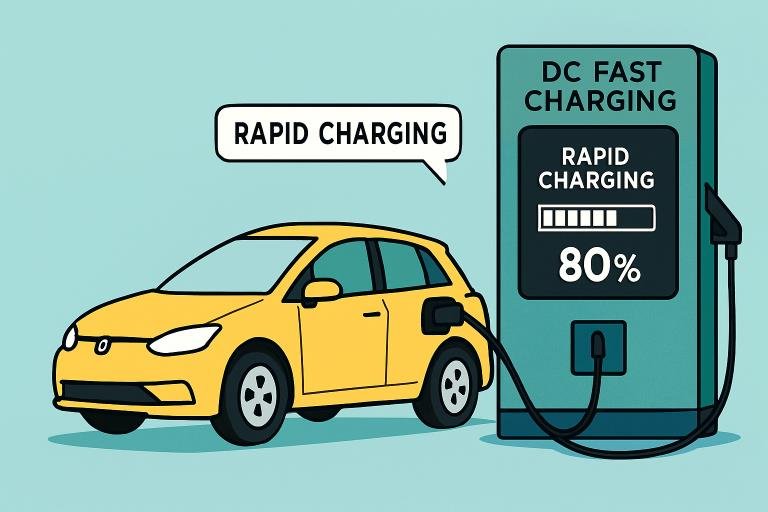DC fast charging is rapidly becoming a cornerstone of electric vehicle (EV) adoption, tackling one of the most persistent challenges for drivers—long charging times. By delivering high-voltage power directly to the battery, these stations can replenish up to 80% of a vehicle’s charge in as little as 30 minutes, making EVs far more practical for daily commutes, road trips, and commercial operations. This speed and convenience help ease range anxiety, build consumer confidence, and open the door for broader EV integration into transportation networks. As automakers release models with faster charging capabilities, and as infrastructure expands, DC fast charging is not just supporting the shift to electric—it’s accelerating it.
Why DC Fast Charging Matters for the EV Revolution
DC fast charging is a game-changer in the electric vehicle (EV) revolution, addressing one of the most significant barriers to adoption—charging speed. Unlike standard Level 2 chargers that can take hours to replenish a battery, DC fast chargers can fully deliver up to 80% charge in 30 minutes or less. This rapid turnaround transforms EVs from a niche choice into a practical option for everyday drivers, long-distance travelers, and commercial fleets. With shorter charging times, drivers experience less downtime, and businesses can keep vehicles on the road longer, improving efficiency and productivity.
Investing in the proper charging infrastructure is key for organizations looking to stay ahead in the shift to sustainable transportation. Businesses can explore Blink’s commercial DC fast charger options to find solutions that balance speed, reliability, and scalability. These chargers meet today’s EV drivers’ needs and prepare businesses and communities for a future where electric mobility is the norm.
Charging Levels: The Basics Explained
To fully appreciate the impact of DC fast charging, it’s essential to understand how different charging levels work. Level 1 charging utilizes a standard residential outlet and provides a modest 3-5 miles of range per hour—a pace suited only for overnight charging. Level 2 charging ups the ante, using a 240V outlet to deliver between 12 and 80 miles per hour, depending on the vehicle and equipment. While Level 2 is standard in homes and public venues, it remains slow for extended trips or high-utilization vehicles.
- Level 1:Standard residential outlet, 3-5 miles/hour of charge
- Level 2:240V outlet, standard in homes and public, 12-80 miles/hour
- DC Fast Charging:Up to 80% battery in 20-40 minutes, vehicle and station dependent
DC fast chargers stand apart by bypassing the vehicle’s onboard charger and supplying current directly to the battery at much higher power levels. This capability transforms EV charging from an overnight commitment to a quick, en-route convenience, making longer journeys and commercial operations increasingly viable.
Modern Infrastructure and Its Challenges
Developing a seamless DC fast charging network is not as simple as installing new stations. Planners must account for complex issues such as grid connectivity, local power capacity, and the integration of renewable energy sources. Urban areas face additional hurdles with real estate scarcity and zoning regulations, while rural regions often lack incentives for private investment due to lower usage density.
Consumer Perceptions and Overcoming Barriers
One of the most persistent obstacles to mass EV adoption is range anxiety—the fear of running out of battery before being able to recharge. While expanding charger locations addresses this practical concern, overcoming psychological barriers requires transparency and education. User-friendly mobile apps, real-time availability maps, and clear signage give drivers confidence that charging is reliable and accessible. Strategic partnerships between automakers, tech companies, and charging networks are further helping to demystify the process for new adopters.
Data on EV Adoption and Fast Charging Impact
The impact of DC fast charging on EV uptake is evident in the numbers. According to data from the U.S. Office of Energy Efficiency & Renewable Energy, the rapid deployment of public DC fast chargers has gone hand in hand with a significant boost in EV sales. Other international markets with dense fast charging networks, such as Norway and the Netherlands, consistently see EVs capturing a higher share of new car sales, reinforcing the importance of visibility and availability.
Energy Grid and Power Supply Considerations
While the rapid expansion of fast charging is significant for drivers, it introduces new demands on the power grid. High-output chargers can create peak demand spikes, potentially stressing local infrastructure, especially during high usage periods. Innovative solutions are being adopted to balance these challenges. Battery storage systems at charging locations store energy during off-peak periods and deliver it when demand surges. Some stations are integrating solar and wind energy, further enhancing sustainability. Utilities and site operators also embrace demand response programs to align charging activity with overall grid health—supporting robust power reliability as adoption scales.
- Energy storage reduces peak power loads on local grids
- Demand response helps balance real-time grid needs
- Integration of renewables lowers fossil fuel reliance
How Government Initiatives Are Supporting DC Fast Charging
Government action remains pivotal in driving widespread deployment of DC fast charging. Countries and local governments are rolling out a patchwork of subsidies, tax credits, and grants to spark private investment and fill infrastructure gaps. New fast chargers are required along key highways and corridors in many places, ensuring that charging access is equitable and comprehensive. These policies not only bolster consumer confidence but also create economies of scale that drive down costs and accelerate technological progress. See the U.S. Department of Energy’s federal and state electric vehicle policies summary for more perspective.
The Future of Fast Charging Technologies
The fast charging landscape continues to evolve quickly, with new advances promising to reduce charging times further and improve system reliability. Developments in battery chemistry—like the move toward silicon-based anodes—could deliver rapid charging with minimal degradation. On the hardware side, charger interoperability and diagnostics improvements will maximize uptime and minimize maintenance delays. Looking forward, vehicle-to-grid (V2G) technology may turn EVs into distributed energy assets, helping to stabilize grids while offering new value to owners and operators.
- Ongoing reduction in charging times
- Greater charger compatibility and interoperability
- Advanced diagnostics and remote monitoring
Conclusion: Accelerating Towards an Electric Future
DC fast charging stands at the crossroads of technology, infrastructure, and consumer experience, making it a cornerstone of the global EV transformation. Rapid charging empowers broader adoption and supports emissions reduction goals by tackling the dual challenges of convenience and confidence. Collaboration between innovators, policymakers, and private enterprise will ensure these networks grow smarter and more accessible, pushing the world closer to a sustainable, electrified transportation future.



